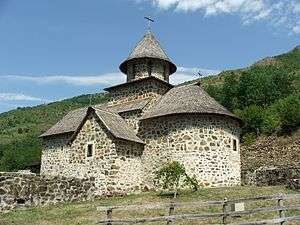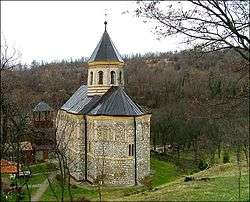Raška architectural school
Raška architectural school (Serbian: Рашка школа архитeктуре), also known as the Raška style (Рашки стил, Raški stil), or simply as the Raška school, is an ecclesiastical architectural style that flourished in the Serbian High Middle Ages (ca. 1170–1300), during the reign of the Nemanjić dynasty. The style is present in the notable Morača Monastery, Uvac monastery and Dobrilovina monastery, among many others. This style combines traditional Slavic architecture with early Christian church-design, and often utilizes a combination of stone and wood material.
Examples
- Rmanj Monastery, built by Katarina Branković, daughter of Serbian despot Đurađ Branković in 1443.
- Uvac Monastery, built by the Nemanjic dynasty in the 13th century
- Gomionica monastery, built in the 15th century
- Kumanica monastery, built in the 15th century
- Mala Remeta Monastery, built by King Dragutin in the 13th century.
- Dobrilovina Monastery, built before the 16th century
- Monastery Moštanica, built by King Dragutin in the 13th century
- Morača Monastery, built by Stefan Vukanović in 1252
-

Rmanj, built in 1443
-

Monastery Uvac
-

Gomionica
-
Dobrilovina
-
Monastery Moštanica is located near Kozarska Dubica
-

Kumanica
-

Mala Remeta
-

Monastery Moraca built in 1252 by Stefan Vukanović Nemanjić
See also
References
Sources
- Народни музеј у Београду (2015). "Рашка школа архитeктуре". Догађања. National Museum of Serbia.
- Sir Banister Fletcher; Dan Cruickshank (1996). Sir Banister Fletcher's a History of Architecture. Architectural Press. pp. 322–. ISBN 978-0-7506-2267-7.
This article is issued from Wikipedia - version of the 11/19/2016. The text is available under the Creative Commons Attribution/Share Alike but additional terms may apply for the media files.
